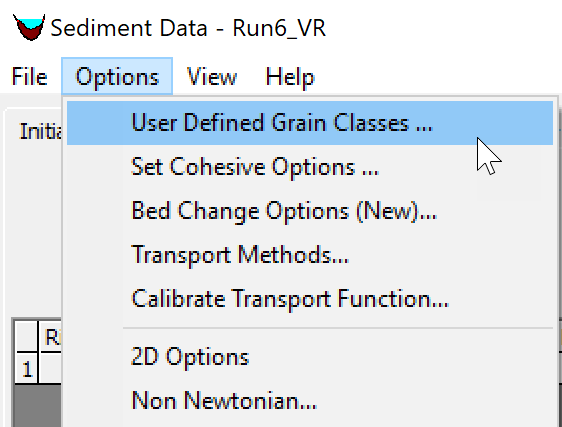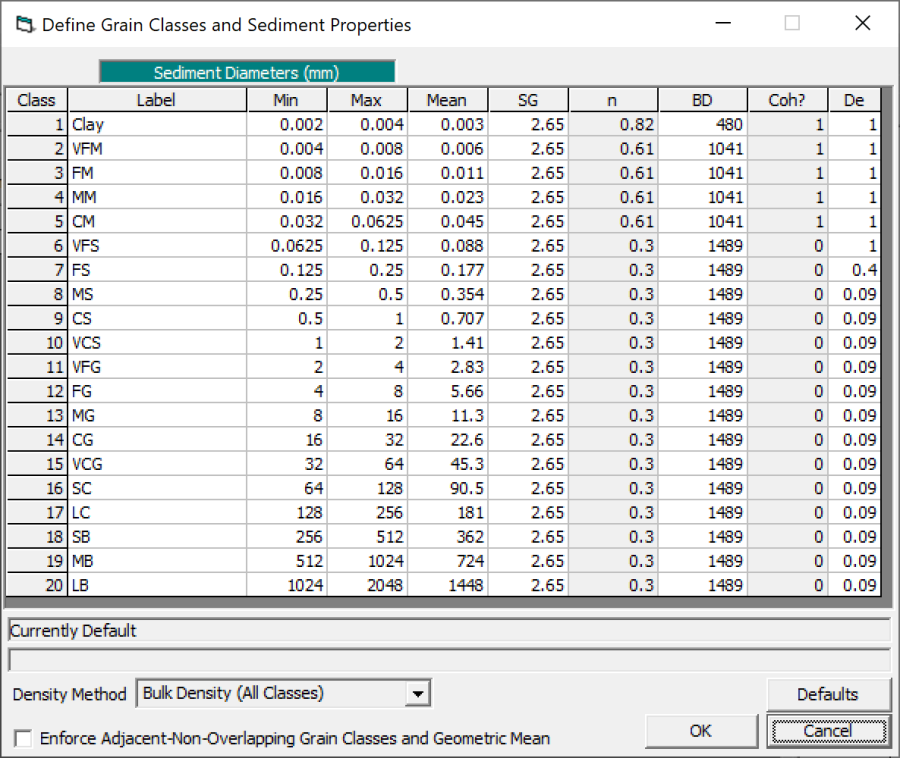Download PDF
Download page User-Defined Grain Classes.
User-Defined Grain Classes
HEC-RAS divides the sediment material into multiple grain classes. Default grain classes sub-divide the range of transportable material, (0.002 mm to 2048 mm) into 20 grain classes or bins, each including adjacent, non-overlapping fractions of the grain size spectrum. Default grain classes follow a standard log base 2 scale where the upper bound of each class is twice its lower bound, the upper bound of the smaller, adjacent class. The gain class represents all particles they contain with a single, representative grain size. HEC-RAS uses the geometric mean of the grain class to represent the grain size for each bin. Grain boundaries (and labels) are editable.
The user may change the size range for the grain classes by going to the Sediment Data editor and selecting Options | User Defined Grain Classes… (see figure below).

Figure 1. Opening the User Defined Grain Classes editor from the Sediment Data editor.
In the User Defined Grain Classes editor (see figure below), the user may change the diameter limits, names of the grain classes, and sediment properties including the Specific Gravity (SG), Porosity, dry Bulk Density (BD). The label (name) for each grain class may be changed in the table. The labels are used in the sediment output to identify variables associated with each grain class such as fractional concentrations and particle fall velocities. It is important to note that for 2D sediment transport, not all the grain-classes in the User Defined Grain Classes editor are actually used by the model. Only the grain classes which exist in the Sediment Bed Gradations and/or the sediment boundary conditions are used. This saves computational time and memory since only the grain classes which exist in the 2D domains are used. Therefore, the number of grain classes in 1D and 2D sediment may be different.

Figure 2. User Defined Grain Classes editor.
The grain size classes can be viewed as analogous so the grid resolution. When initially setting The table below shows typical specific gravity ranges for different common minerals and rocks.
Table 1. Specific gravity ranges for different minerals and rocks.
Material | Specific Gravity |
Quartz | 2.6 – 2.7 |
Limestone | 2.6 – 2.8 |
Basalt | 2.7 – 2.9 |
Magnetite | 3.2 – 3.5 |
Coal | 1.3 – 1.5 |
The grain specific gravity should not be used as calibration parameter. It is a parameter of the sediment particles and should be specified as accurately as possible. However, in general the results are generally not very sensitive to the specific gravity for natural sediments in rivers.
Density Methods
The Density Method refers to the methods used to specify the grain class dry density/porosity/unit weight:
- Bulk Density (All Classes)
- Porosity (All Classes)
- UW-Cohesive/Porosity-Cohesionless
The default Density Method is Bulked Density (BD). To specify a different Density Method, the user may select one of the options in the drop down menu as shown in the figure below.

Figure 3. Selecting the Density Method in the Define Grain Classes and Sediment Properties editor.
Depending on the choice selected the appropriate columns will be enabled or grayed out in the User-defined Grain Classes editor. If the Bulk Density method is selected the BD (for dry bulk density) column is enabled. The program computes a grain class porosity from the specific gravity (column labeled SG) which may not be the same as the values in the grayed-out porosity (column labeled n). If the Porosity (All Classes) method is selected, the specific gravity and porosity columns are enabled. The program internally computed a dry bulk density from the specific gravity and porosity, which may not be the same as that which is displayed in the editor. The last option is the UW-cohesive/Porosity-Cohesionless method. In this method the dry bulk density is specified for cohesive grain classes, and the porosity is specified for the cohesionless (noncohesive) grain classes.
The treatment of the dry bulk density in HEC-RAS 2D sediment is different from that of HEC-RAS 1D. In 2D the bulk density is treated as a property of the sediment mixture and there is not always a one-to-one relationship between the grain class fractions and the bulk density. This is necessary to simulate processes such as packing and consolidation.
If all the utilized grain class (cohesive and noncohesive) have the same bulk density and consolidation is not enabled, a constant bulk density is assumed, which significantly simplifies the computations. If the specified bulk densities or porosities for the noncohesive grain classes are variable, a variable bed density model is utilized with the bed porosities calculated from the Colby (1963) formula. The variable bed density model is more computationally expensive because it requires several more calculations and steps during the simulation. If the dry densities or porosities are left empty, then the Wooster et al. (2008) porosity formula is utilized based on the sediment sorting. Dry densities generally vary between 300 to 1,600 kg/m3.